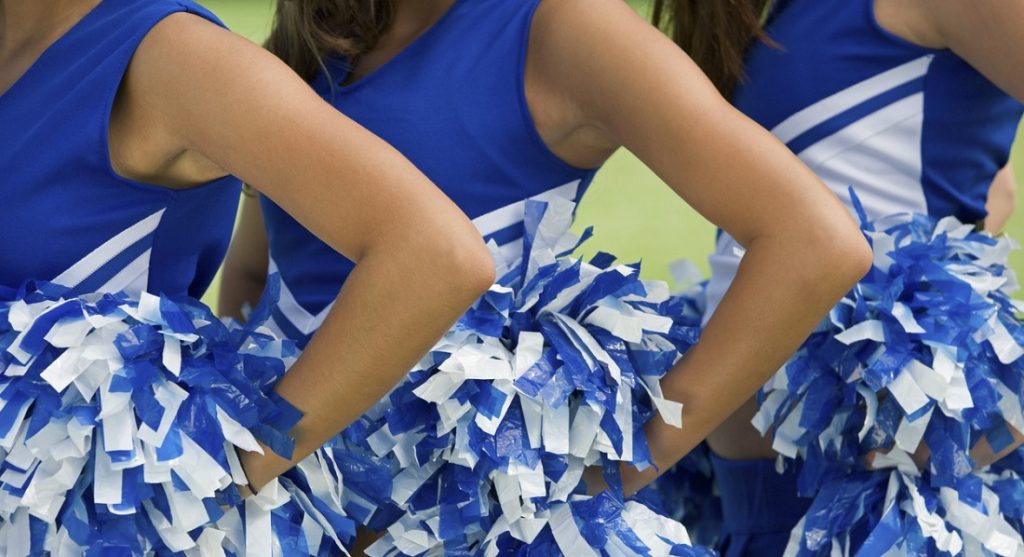Confession time: I am that rare person who really, truly loved my time in high school. Sure, there were orthodontic struggles and questionable fashion decisions, but as a whole, there’s very little I would have done differently.
Some of my favorite memories from high school are from my time cheerleading. I loved everything about cheering: the big hair, the tumbling, the high-flying stunts and the sense of community at Friday night football games. Looking back, I do have one regret from my high school cheerleading days: the time I spent in the tanning booth.

Here I am at my most tan, covered in bronzer at a national competition.
Cheerleading is an odd activity that requires its participants to worry simultaneously about their athletic prowess and their appearance. Cheerleaders face many of the same dilemmas as dancers and gymnasts, performing gravity-defying acrobatics with added anxiety from worrying about facial expressions and makeup. It isn’t just a vanity concern either: judges can take points off for distasteful uniforms or hair bows falling off. This kind of culture puts pressure on cheerleaders to look a certain way, and often, a tanned look is part of the package.
In my high school, at least, there was no rule that we had to be tan. But just as the media can influence how we want to look, I found that my teammates and coaches did the same. I began considering indoor tanning when I joined the Junior Varsity team, and I heard the older girls complaining about their winter skin. “Ugh, I’m so pale,” was a common refrain during the winter season when we’d cheer indoors for basketball. It was February in upstate New York, so a tanning bed seemed to be a solution to my paleness “problem” and a warm respite from the cold.
The stakes got higher as I got older, and my team attended bigger and more important competitions. Performing under harsh stadium lighting was a thrill, but it was also a dilemma for girls with pale skin. Anyone who has been onstage knows that bright lights mean looking washed out, and stage makeup is a must. Plus, no one wanted to stand out as the palest person on the team and, as a result, possibly draw a judge’s eye. I remember thinking getting ready would be easier if I was already tan to begin with, so prior to any major competition, it was off to the tanning salon.
 Uniformity is a major part of cheerleading, from our movements to our appearance.
Uniformity is a major part of cheerleading, from our movements to our appearance.
Luckily, after I graduated school and left cheerleading behind, I left indoor tanning with it. If I had continued, however, an even more aggressive culture of tanning may have greeted me at higher levels of cheerleading. Many college and professional teams have strict appearance rules for cheerleaders, including that they must maintain a tanned look. Some teams even have their own official tanning salons.
It took me too long to realize that the “healthy glow” I had wanted wasn’t healthy at all. I had known in high school that getting burned was bad, but I truly had no idea that every time I stepped into a tanning booth, I was putting myself at risk for skin cancer. Today, the idea of going indoor tanning is laughable to me. Thanks to my work at The Skin Cancer Foundation, I now know that the ultraviolet radiation emitted by tanning beds is a proven human carcinogen, and people who first use a tanning bed before the age of 35 increase their risk of melanoma by 75 percent. Not only that, but UV radiation also contributes to premature skin aging, like wrinkles and brown spots. No, thank you!
I’ve also learned that it’s not too late to start protecting my skin. Now I incorporate sun protection into my lifestyle and pay careful attention to my skin. I’ve made peace with my natural skin tone, but I know that if I ever find myself craving that bronzed look, sunless tanning options are the way to go. I still look back on my cheerleading days fondly, but I hope the young women joining teams today heed the Foundation’s advice and resist the pressure to UV tan— and in doing so, create a culture that puts their health first.





